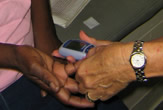Georgia's community health centers see more patients as economy tightens
By Emily Green, Georgia Online News Service
 Staff at the Coastal Medical Access Project in Brunswick started seeing an increase in patients in December, says Pat Kota, executive director of the Coastal Medical Access Project. Many of those patients had been laid off from work and no longer received health insurance and could not afford private coverage.
Staff at the Coastal Medical Access Project in Brunswick started seeing an increase in patients in December, says Pat Kota, executive director of the Coastal Medical Access Project. Many of those patients had been laid off from work and no longer received health insurance and could not afford private coverage.
Total increase over the four-month period was 25 percent, says Kota. The Coastal Medical Access Project provides health care for the uninsured and the underinsured.
Today, with one in five Georgians without health insurance, community health centers that provide services at reduced rates are seeing a surge in the number of patients. Rural and urban communities are both struggling to meet the increased need, however rural health centers don't have nearly as many resources to handle the demand as their urban counterparts.
Brunswick is a medium-sized city of about 100,000 people. While not itself affluent, it is located close to well-off coastal towns. At the clinic, artwork adorns the hallways, plush couches fill the waiting room and a large flat screen television hangs on the wall.
Kota says the state-of-the-art facility exists because of donations from the community. The Ritz-Carlton donated furniture, a local dentist gave six dental chairs worth $5,000 apiece to the clinic, and the local rotary club donated an EKG machine. The center moved into its new building in December, leasing it from the local hospital for all of $1 a year.
"There's been an increase in the number of requests for primary care, specialty care, vision, dental. It's the perfect storm. We have a better facility, more volunteers, and a greater need. And it's all coming together at the exact same time," says Kota.
Rural communities have less ability to financially maneuver in tough times, says Katherine Cummings, executive director of the Georgia Rural Health Association. Not only is their less money and greater poverty in rural districts, but there are fewer people.
"If you look at a rural community where you have traditionally a shortage of professionals, then they are already working long hours to do the job that they have to do in their paid position. So to ask them to turn around and volunteer -- there just aren't that many human beings in the community to do that work," says Kota.
The rural Sandersville Community Health Center does not have any volunteers - a stark contrast to the more than 200 volunteer doctors, nurses and surgeons the Brunswick clinic depends on to provide most of the actual medical care. At the Sandersville clinic, one doctor and one physician's assistant provide basic primary care treatment for conditions like hypertension, heart disease and obesity.
Connie Hutchison is one of the uninsured patients who seek medical care at the Sandersville center. Hutchison has high blood pressure and has been coming to the clinic since it opened six years ago. She says she would never think about going anywhere else.
"It's wonderful. Matter of fact, I recommend if for everyone to come. Even if you got insurance or got plenty of money I recommend you come. They're really good up here. I love them."
Carla Belcher oversees the Sandersville clinic and others like it in the area. She says they fill a vital need in their communities.
"A lot of what happens with patients who are uninsured is they end up not seeing a doctor at all until they are so sick that they don't have a choice, and so what really ends up happening is that they go to the emergency room, which is an expensive way to receive primary care. And by the time they get there they may end up needing a lot more care than if they had been seeing a primary care doctor on a regular basis."
More aid for community health care centers may be on the way. Georgia has already received $1.2 million dollars to expand rural community health care centers from the federal stimulus package and officials say they expect more money to come.
 Staff at the Coastal Medical Access Project in Brunswick started seeing an increase in patients in December, says Pat Kota, executive director of the Coastal Medical Access Project. Many of those patients had been laid off from work and no longer received health insurance and could not afford private coverage.
Staff at the Coastal Medical Access Project in Brunswick started seeing an increase in patients in December, says Pat Kota, executive director of the Coastal Medical Access Project. Many of those patients had been laid off from work and no longer received health insurance and could not afford private coverage.Total increase over the four-month period was 25 percent, says Kota. The Coastal Medical Access Project provides health care for the uninsured and the underinsured.
Today, with one in five Georgians without health insurance, community health centers that provide services at reduced rates are seeing a surge in the number of patients. Rural and urban communities are both struggling to meet the increased need, however rural health centers don't have nearly as many resources to handle the demand as their urban counterparts.
Brunswick is a medium-sized city of about 100,000 people. While not itself affluent, it is located close to well-off coastal towns. At the clinic, artwork adorns the hallways, plush couches fill the waiting room and a large flat screen television hangs on the wall.
Kota says the state-of-the-art facility exists because of donations from the community. The Ritz-Carlton donated furniture, a local dentist gave six dental chairs worth $5,000 apiece to the clinic, and the local rotary club donated an EKG machine. The center moved into its new building in December, leasing it from the local hospital for all of $1 a year.
"There's been an increase in the number of requests for primary care, specialty care, vision, dental. It's the perfect storm. We have a better facility, more volunteers, and a greater need. And it's all coming together at the exact same time," says Kota.
Rural communities have less ability to financially maneuver in tough times, says Katherine Cummings, executive director of the Georgia Rural Health Association. Not only is their less money and greater poverty in rural districts, but there are fewer people.
"If you look at a rural community where you have traditionally a shortage of professionals, then they are already working long hours to do the job that they have to do in their paid position. So to ask them to turn around and volunteer -- there just aren't that many human beings in the community to do that work," says Kota.
The rural Sandersville Community Health Center does not have any volunteers - a stark contrast to the more than 200 volunteer doctors, nurses and surgeons the Brunswick clinic depends on to provide most of the actual medical care. At the Sandersville clinic, one doctor and one physician's assistant provide basic primary care treatment for conditions like hypertension, heart disease and obesity.
Connie Hutchison is one of the uninsured patients who seek medical care at the Sandersville center. Hutchison has high blood pressure and has been coming to the clinic since it opened six years ago. She says she would never think about going anywhere else.
"It's wonderful. Matter of fact, I recommend if for everyone to come. Even if you got insurance or got plenty of money I recommend you come. They're really good up here. I love them."
Carla Belcher oversees the Sandersville clinic and others like it in the area. She says they fill a vital need in their communities.
"A lot of what happens with patients who are uninsured is they end up not seeing a doctor at all until they are so sick that they don't have a choice, and so what really ends up happening is that they go to the emergency room, which is an expensive way to receive primary care. And by the time they get there they may end up needing a lot more care than if they had been seeing a primary care doctor on a regular basis."
More aid for community health care centers may be on the way. Georgia has already received $1.2 million dollars to expand rural community health care centers from the federal stimulus package and officials say they expect more money to come.
